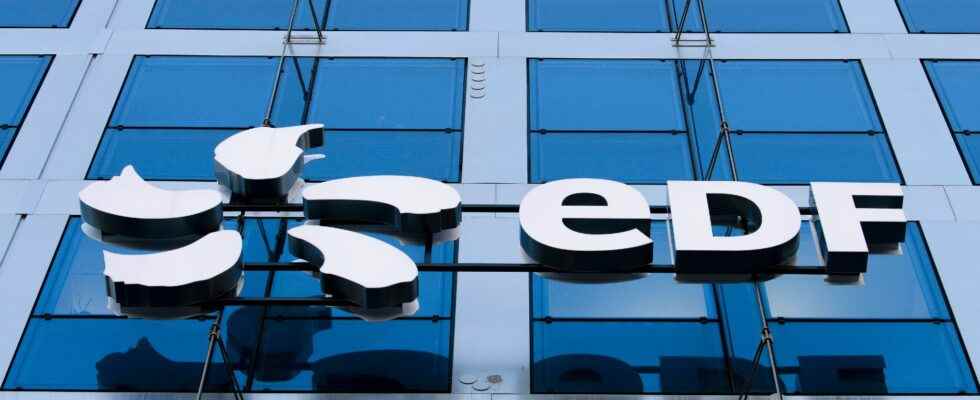A black year. Weighed down by the setbacks of its nuclear fleet but also its forced contribution to the “tariff shield” of the French, EDF recorded in 2022 a historic loss of 17.9 billion euros, widening its debt to an equally record level of 64.5 billion euros, as announced by the electricity giant this Friday, February 17.
Its turnover increased by 70% to 143.5 billion euros driven by the rise in energy prices, but the group went into the red with a very heavy net loss, against a profit of 5.1 billion in 2021. “Bruno Le Maire and Agnès Pannier-Runacher take note of the deterioration in EDF’s financial situation, a consequence of the low production in 2022”, reacted the Ministers of Economy and Energy transition this Friday, a few minutes after the announcement of disastrous annual financial results by the electrician, in which they nevertheless maintain “all confidence”.
With the general surge in electricity prices, EDF saw many French customers return, but the operating margin suffered from purchases at exorbitant prices to cover their needs. “Despite a strong increase in turnover supported by electricity and gas prices, EBITDA is strongly penalized by the drop in nuclear production as well as the exceptional regulatory measures put in place in France for 2022, in difficult market conditions”, commented Thursday, February 16 for some journalists the CEO Luc Rémont.
On the other hand, the manager confirmed “the nuclear production range of 300 to 330 TWh (in 2023), i.e. a gradual exit from the stress corrosion crisis” noted on portions of the pipes, which had shut down many reactors since the end of 2021.
The average availability of the fleet of 56 reactors is falling
In July 2022, EDF announced a historic loss in the first half of 5.3 billion euros alone. “At a time when electricity is expensive, the megawatt hour that we do not produce is a terrible shortfall”, indicated a few weeks ago to AFP Julien Teddé, general manager of the broker Opéra Energie.
The operator EDF has indeed accumulated the problems between the discovery of corrosion on pipes crucial for the safety of nuclear power plants and the delays in their maintenance because of Covid-19. Result: in 2022, the average availability of the fleet of 56 reactors fell to 54% (compared to 73% over the period 2015-2019), raising the threat of power cuts in the middle of winter. In the end, the worst was averted thanks to electricity imports, French sobriety efforts and EDF’s race to reconnect its reactors.
Never so few terawatt hours of nuclear origin had been produced since 1988, before the end of the construction of the nuclear fleet: 279 TWh in 2022. Far from the time when EDF spat out 430 TWh as in 2005. arrange, the electricity production of its dams, undermined by exceptionally dry and hot weather, fell to its “lowest level” since the memorable drought of 1976, indicated Thursday, February 16 RTE, the manager of the transport network of ‘electricity.
After a year 2022 marked by historically low electricity production, the government said on Friday that it was counting on Luc Rémont and the group’s employees, to “restore all of EDF’s electricity production as soon as possible”. “The recovery of EDF’s finances will go primarily through the increase in the volume of production”, commented the Minister of Economy Bruno Le Maire and the Minister of Energy Transition Agnès Pannier-Runacher.
“The more megawatts there are, the better off EDF will be”
The war in Ukraine hit the nail on the head with soaring gas and electricity prices. Because to contain the bill of the French thanks to the tariff shield, the State, majority shareholder, forced the group to sell in 2022 more electricity at low prices to its competitors, alternative electricity suppliers. A measure at an exorbitant cost for the incumbent operator: 8.34 billion euros. The group had to buy electricity at exorbitant prices on the markets, being forced to resell it at a knockdown price.
Regularly denounced by EDF and the unions, this mechanism called “Arenh” was built by France in 2010 to try to stay in the nails of the competition imposed by Brussels. How ? By forcing EDF to sell part of its nuclear production (100 TWh) to its competitors at the cost price of 42 euros per MWh.
Just before taking up his duties as CEO, Luc Rémont, instructed by the executive to present a rescue recipe by next spring, affirmed in October 2022 that this system was “out of breath” and induced “an under- remuneration” for EDF’s nuclear activity.
Abyssal debt? “We will not be alone”, argues EDF, since the State is in the process of renationalising 100% of the company in order to organize the deployment and financing of its ambitious nuclear recovery plan announced a year ago. by Emanuel Macron. The objective is clear: to “produce more” carbon-free energy. “The more megawatts there are, the better off EDF will be,” declared Economy Minister Bruno Le Maire last December.
